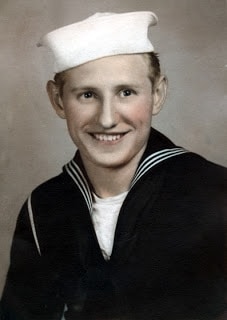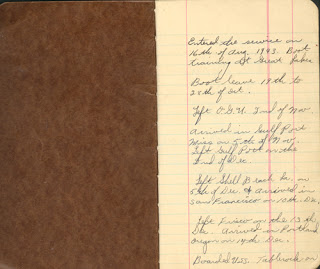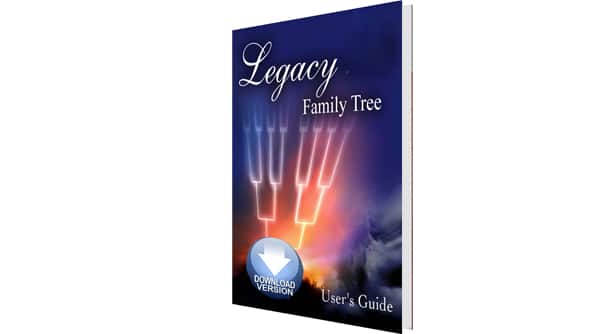Thanks to guest blogger, Lisa A. Alzo, for this article.

November we observe Veterans Day in the United States to honor armed service
veterans. For genealogists, researching
military records can often turn up valuable clues not found in other documents.
Many
years ago, while preparing to sell my parents’ house after they had passed
away, I found a small brown, unmarked notebook in one of my father’s closets.
Out of curiosity I flipped through it, and to my surprise, discovered it was a
diary of sorts—notes that my father kept during his service in the United
States Navy during World War II. It really wasn’t a diary, but rather a log of
the events from the time he entered the service (he was drafted two months after
his high school graduation in 1943) until his final notation on August 14,
1945.
While my
dad was not all that interested in genealogy, and knew very little about his
ancestors, he was always willing to talk about his time serving in World War II. He said when he was drafted he actually
got to choose which branch of service, so he chose the Navy. Why? “So he
wouldn’t have to sleep in a foxhole.” In the Navy, he would have a bunk. Dad
referred to his days on the ship as being on “a floating bomb” because the ship
on which he served carried hauled fuel for the fighter planes.
My father
was not much of a writer, so it was a pleasant surprise indeed to find this
little gem. A couple of interesting entries included:
“Entered
the service on 16th of August 1943. Boot training at Great Lakes”
“Boarded
U.S.S. Tablerock on 15th of December”
“Dec.
25th – First Christmas away from home.”
“December
27 picked up invasion barges in Wilmington, CA.”
“Dec. 28
– Left Wilmington for Pearl Harbor at 5:00 p.m.”
“Dec. 29 – 1st verge of seasickness.
“June 11
– Arrived in Panama 10:00 p.m. Eleven hrs. to get thru locks.”
“June 12
– Met Whitey Petrisko” (his best friend from home who was in the Army).
And
another very interesting entry in 1945:
“Ships position
at time of surrender: August 14, 1945. Time 12:31 10º N by 164º W.”
While my
father’s notes are a pretty cut and dry account of his military service, at
least I have some written testimony of his experiences as part of “The Greatest
Generation” and a piece of my father that I can always keep with me now that he
is gone—something to give me greater insight into his life as a young man.

addition to this journal/diary, I have a photo album with many snapshots of my
father during his time in the U.S. Navy, as well as an address book listing the
names of some of his fellow servicemen, my father’s induction notice, dog tags,
and discharge papers. These items have
provided great details for telling the story of my father’s life.
If you
are not able to find any documents or photographs related to your ancestor’s
military service in home and family sources, there are plenty government
resources you can consult, including:
- Compiled service records
- Pension Applications and Pension Payment
Records - Headstones and Grave markers
- Draft registration cards
- Bounty land warrant application files
- Oral histories
- Newspaper articles
- Town/local histories
Where to Find Military Records
In
addition to home and family sources, you can locate military records for your
ancestors using both free and pay-for-access sites and databases. Subscription sites, Ancestry.com
and Fold3 have a number of indexes and
records online. The National Archives Records
Administration (NARA) holds Federal military service records in two
repositories: National
Archives Building in Washington, DC (Revolutionary War – 1912) and the National
Military Personnel Records Center (NPRC) in St. Louis, Missouri (WWI –
present). Some additional records may
be found at NARA regional archives
reading rooms. While a majority of
NARA’s holdings are not online—there are two online collections you may find
useful: The
Archival Research Catalog (ARC) and Access to
Archival Databases (AAD) System. Other
state and local libraries or repositories should also be checked. For oral histories, check out the Veterans History Project at the Library of
Congress. In addition, check FamilySearch for digitized collections
(e.g. United
States, World War I Draft Registration Cards, 1917-1918; US. World
War II Draft Registration Cards, 1942; Index
to Naturalizations of World War I Soldiers, 1918; and United
States, Applications for Headstones for Military Veterans, 1925-1941), and
others you can explore from
home (check also by state for special or unique collections). Of course, there are also records still only
available via FHL microfilm you can rent for a fee through your local FamilySearch Center. For more online resources, consult Joe
Beine’s free site: Genealogy
Research Guides – Military Records.
Military Education from Legacy Family Tree
- Webinar: Your Civil War Ancestors: Beginning Your Research by Michael Hait
- Legacy QuickGuide: Researching Your Loyalist Ancestors
- Legacy QuickGuide: Researching Your U.S. Civil War Ancestors
- Legacy QuickGuide: World War I and World War II Military Records
- Legacy QuickGuide: Researching First and Second World War Canadian Records
I’m
grateful to my father and all veterans for their brave and dedicated service to
our country. Veterans Day is a great
time to discover the heroes in your family tree, but thankfully, you don’t have
to limit your research to the month of November—use the above resources to
research military service records all year long!
Lisa A.
Alzo is a freelance writer, instructor, and lecturer who has been tracking her
ancestors for more than 23 years. She is a frequent presenter for the Legacy
Family Tree Webinars series and can be contacted via http://www.lisaalzo.com.





Comments (0)